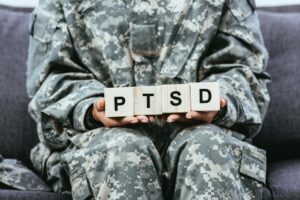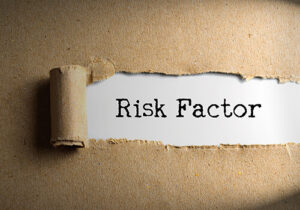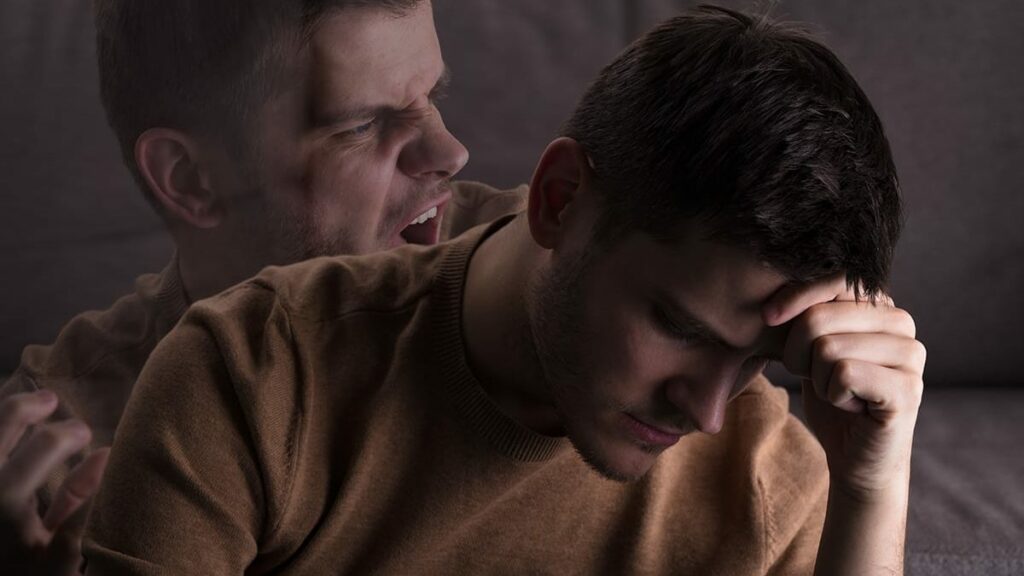Chronic PTSD is a relatively new term that is being used to describe Post-Traumatic Stress Disorder that lasts for more than three months. It can be difficult to diagnose because the symptoms can be very similar to those of other mental health disorders. In this blog post, we will discuss chronic PTSD and how to cope with it if you are diagnosed with it.
Contents
What Is Chronic PTSD?
 Chronic PTSD is a type of post-traumatic stress disorder (PTSD) that can occur after someone experiences a traumatic event. Unlike regular PTSD, chronic PTSD lasts for months or years after the event has occurred. This can lead to problems with work, relationships, and everyday activities.
Chronic PTSD is a type of post-traumatic stress disorder (PTSD) that can occur after someone experiences a traumatic event. Unlike regular PTSD, chronic PTSD lasts for months or years after the event has occurred. This can lead to problems with work, relationships, and everyday activities.
This condition is simply described as having PTSD that lasts for more than three months after the event. However, this doesn’t mean that the symptoms will go away after three months. For some people, the symptoms may lessen over time, but they can still have a major impact on day-to-day life.
Therefore, if you are struggling with PTSD, it is important to seek treatment as soon as possible. There are many effective treatments available, including therapy and medication. With the right treatment, you can manage your symptoms and live a fulfilling life.
How Can You Recognize It?
There are a number of symptoms that can help you to recognize if someone has chronic PTSD. These symptoms can be divided into three categories:
Re-experiencing the trauma
This can include flashbacks, nightmares, and intrusive thoughts about the event. The person may feel like they are going through the experience again. It is often accompanied by physical symptoms, such as a racing heart or sweating. For example, a car accident survivor may have flashbacks of the crash whenever they hear a loud noise.
Re-experiencing the trauma in this type of PTSD is constant, which can make it hard to move on from what happened. The person may feel like they are stuck in the past and unable to move forward.
Avoidance
The person may try to avoid anything that reminds them of the trauma. This can include people, places, activities, and even thoughts or feelings. The avoidance may be so severe that it interferes with their daily life. Avoidance can manifest itself in different ways, such as:
- Physical avoidance. This may mean avoiding places or activities that remind them of the trauma. For example, a war veteran may avoid watching movies about war, or a survivor of a car accident may avoid driving.
- Emotional avoidance. The person may try to numb themselves emotionally in order to avoid confronting the pain of the trauma. They may do this by using alcohol or drugs, withdrawing from friends and activities, or becoming emotionally distant.
- Cognitive avoidance. The person may try to avoid thinking about the trauma or suppress memories of it. They may do this by keeping themselves busy or distracted, or by avoiding people or places that remind them of the event.
It’s important to remember that avoidance is a natural and normal response to trauma. It’s a way of coping with the pain and trying to protect oneself from further hurt.
Hyperarousal
 This symptom is described as a feeling of being on edge. You may be jittery, always alert, and have trouble sleeping. You might also startle easily. For example, if you hear a loud noise, your body may instinctively react as if you’re in danger. You might also have sudden outbursts of anger.
This symptom is described as a feeling of being on edge. You may be jittery, always alert, and have trouble sleeping. You might also startle easily. For example, if you hear a loud noise, your body may instinctively react as if you’re in danger. You might also have sudden outbursts of anger.
People feel this way because their fight-or-flight response has been activated. This is the body’s natural way of responding to danger. When you have chronic PTSD, your body doesn’t know how to turn off this response.
So these are the three types of symptoms that a person with chronic PTSD may experience. But it’s important to remember that everyone experiences these symptoms differently. Some people may only have one or two of these symptoms, while others may have all three. And the severity of the symptoms can vary from person to person.
How Chronic PTSD Is Different From Acute PTSD?
Many people think of PTSD as something that only affects soldiers who have been in combat. However, anyone who has experienced a traumatic event can develop PTSD. And PTSD can actually be divided into two different types: acute and chronic.
Acute PTSD is the more “traditional” form of the disorder, and it typically develops within a few months of the traumatic event. Chronic PTSD, on the other hand, can develop years after the trauma has occurred. There are a few key differences between chronic and acute PTSD.
- First, chronic PTSD is characterized by more severe and long-lasting symptoms. These can include flashbacks, nightmares, anxiety, depression, and intrusive thoughts.
- Second, chronic PTSD often leads to social isolation and withdrawal. This is because sufferers may feel like they can’t trust anyone or that no one could possibly understand what they’re going through.
- Third, chronic PTSD can have a major impact on someone’s ability to function in their daily life. This may include problems with work, school, and personal relationships.
If you think you may be suffering from chronic PTSD, it’s important to seek professional help. A therapist can provide you with the support and treatment you need to cope with your symptoms and start living a more normal life.
What Are The Causes And Risk Factors?
 There is no single cause of chronic PTSD. However, there are certain risk factors that can make a person more susceptible to developing the condition. These include:
There is no single cause of chronic PTSD. However, there are certain risk factors that can make a person more susceptible to developing the condition. These include:
- Experiencing a traumatic event or series of events
- Having a history of trauma or abuse
- Having a family history of mental illness
- Having a personal history of mental illness
- Being exposed to a traumatic event through media or secondhand accounts
It is believed that chronic PTSD develops as a result of a combination of these risk factors. Because the word chronic is defined as lasting a long time or recurring frequently, it is not surprising that chronic PTSD is often characterized by symptoms that last for months or even years.
Henceforth, if you or someone you know is struggling with chronic PTSD, it is important to seek professional help. With time you can learn to cope with your symptoms and eventually live a normal, healthy life.
How Chronic PTSD Impacts Life?
Chronic PTSD can have a significant impact on every aspect of an individual’s life. These include:
Interpersonal relationships
Chronic PTSD can make it difficult to maintain healthy and supportive relationships. The individual may feel isolated, mistrustful, and become easily angered. They may also avoid social situations altogether.
Occupational functioning
The individual may struggle to maintain employment due to the symptoms of chronic PTSD. The symptoms can make it difficult to concentrate, remember things, and make decisions. The individual may also experience fatigue and sleep problems, which can lead to absenteeism.
Physical health
Chronic PTSD can take a toll on an individual’s physical health. The symptoms can cause headaches, gastrointestinal problems, and sexual dysfunction. A person may also be at increased risk for heart disease and other chronic health conditions.
So these are some of the ways chronic PTSD can impact an individual’s life. If you or someone you know is struggling with chronic PTSD, there are treatment options available. With proper help and support, it is possible to manage the symptoms and live a fulfilling life.
How Can You Treat It?
This is very essential in order to get better and to feel better. It is not only important for you but also for your loved ones. They need to see you improving and feeling better as well. Here are some ways that PTSD can be treated:
Talk therapy or counseling
 It is one of the most popular and effective ways to treat PTSD. It allows you to talk about your experiences and how it has affected you. For example, in talk therapy, you might:
It is one of the most popular and effective ways to treat PTSD. It allows you to talk about your experiences and how it has affected you. For example, in talk therapy, you might:
- Explore your feelings and reactions to the trauma
- Work through any guilt, anger, or shame you feel
- Learn how to cope with flashbacks and nightmares
- Develop healthy coping skills
- Learn about post-traumatic stress disorder and how it’s affecting you
It is believed that talk therapy or counseling can help you make sense of what happened, and it can also help you process your emotions. Counseling can also provide you with tools to deal with your symptoms. If you feel like talk therapy or counseling is not for you, there are other options available.
Exposure therapy
This type of therapy is often used to treat PTSD and can be very effective. It involves gradually exposing yourself to the things that trigger your PTSD symptoms in a safe and controlled environment. This can help you learn to manage your symptoms and eventually reduce them.
In fact, it involves some techniques that are similar to those used in exposure therapy, such as relaxation techniques and imaginal exposure. However, it also incorporates elements of cognitive behavioral therapy (CBT) to help you change the negative thoughts and beliefs that may be contributing to your PTSD symptoms.
Cognitive behavioral therapy (CBT)
CBT is a type of psychotherapy that helps people to change their negative thoughts and behaviors. This has been shown to be an effective treatment for chronic PTSD. It is believed that CBT helps people to learn new skills and ways of thinking that can help them to cope with their symptoms.
Eye movement desensitization and reprocessing (EMDR)
EMDR is a type of therapy that is effective in treating chronic PTSD. This therapy can help you to process and heal from your trauma. EMDR is a structured form of therapy, and it uses eye movements or other forms of bilateral stimulation to help you access and process your memories.
It works by helping you to access and process your memories in a way that is less distressing and more adaptive. EMDR has been found to be an effective treatment for chronic PTSD, and it can help you to heal from your trauma.
Medication
There are a variety of medications that can be used to help people with chronic PTSD. The most commonly prescribed class of drugs is antidepressants. These can be helpful in reducing the symptoms of PTSD, but they don’t work for everyone. Other types of medications that may be helpful include:
- Anti-anxiety drugs
- Mood stabilizers
- Antipsychotic drugs
- Sleep medications
You should talk to your doctor about what type of medication might be right for you. It’s important to remember that medications can have side effects, so it may take some trial and error to find the right one.
If you are feeling like you need help or that you can’t cope, please seek professional help. This is not something that will go away on its own. It takes time, patience, and strength to deal with chronic PTSD. But you can get through it!
Does Chronic PTSD Ever Go Away?
 This is a question that people ask a lot. The answer is not a simple one. For some people, chronic PTSD can go away on its own. This is more likely if the person has a strong support system, healthy coping mechanisms, and does not have any other mental health disorders.
This is a question that people ask a lot. The answer is not a simple one. For some people, chronic PTSD can go away on its own. This is more likely if the person has a strong support system, healthy coping mechanisms, and does not have any other mental health disorders.
If the person has these things going for them, they have a much higher chance of eventually recovering from chronic PTSD. There are no guarantees though. For some people, chronic PTSD is a lifelong battle.
In addition, there are some lifelong changes that can occur as a result of chronic PTSD. These changes are not always positive. Some people may find that they are more irritable, have a shorter temper, or are more prone to outbursts of anger. It is important to be aware of these changes and to learn how to cope with them in a healthy way.
Also, maintain a healthy lifestyle which should not be temporary. Eating healthy, exercising, and getting enough sleep are all important things to do when coping with chronic PTSD. Self-care is crucial in managing the symptoms of chronic PTSD.
Chances are that you can manage your chronic PTSD for long periods of time. So do not give up hope. There are treatments and coping mechanisms that can help you live a relatively normal life despite your diagnosis. If you find yourself struggling, do not hesitate to reach out for help from a mental health professional.
Conclusion
In conclusion, chronic PTSD can be a debilitating condition that can have a profound impact on every aspect of your life. However, it is important to remember that you are not alone and there are many resources available to help you cope with the symptoms of chronic PTSD. With the right support, you can learn to manage your symptoms and live a fulfilling life.
If you are struggling then please contact Therapy Mantra for help. The team of experts here will be more than happy to help you out and get you on the path to a better life. Contact us today to learn more about our services. You can also book an online therapy session or download our free Android or iOS app.


